ATS Deployment Guide¶
Introduction¶
This document describes the procedure to setup and run the automatic test system. This assumes that the machine is freshly provisioned.
Reference documents¶
N° |
Document |
code |
Version |
|---|---|---|---|
1 |
Deployment document |
3151_MCS_0036 |
1.0 |
Hardware configuration¶
In this section the needed hardware and its configuration is explained.
Development PC¶
This is a Windows 10 machine where LabVIEW simulators and tools will run. It is currently a Virtual Machine located on a hypervisor under the url tma-windows.ls.lsst.org. It can be accessed on the lsst-wap network or by using the anyconnect or openconnect vpn. Access can be granted by filing an IHS ticket with IT. Also, a specific tool to manage to simulator in the Speedgoat is running here.
Labview
Need your NI account to be granted access by IT to activate a license on the LabVIEW License Server located on lsst-pdm
Warning
lsst-pdm is being replaced sometime in the future. New location is yet to be determined.
Tools needed:
LabVIEW 2018 SP1 - installer zips located on Pavo
LabVIEW License manager - location TBD version should be <= 4.0
JKI LabVIEW VI Package Manager - JKI account needed
NI MAX - included with LabVIEW
LabVIEW packages listed in the table in section 4 of 3151_MCS_0036
VI packages listed in section 4
Tekniker made VIs - location of the files to be solved eventually
Speedgoat¶
The Speedgoat is used to simulate the main axis behavior in real time.
Speedgoat
Serial Number: 4539 (ItemID 109200)
Options:
CPUCorei74200 (ItemID 109211)
SSD500GB (ItemID 109048)
- Input/Output modules:
Ethercat Slaves, IO750 (x2) (ItemID 2B7506)
IO 306
Software configuration will be downloaded using Tekniker made tool.
Tools needed:
MatLab 2020a
Simulink
Speedgoat IO libraries
PILZ CPU¶
This will be used to simulate and test safety software
PIlz PSSu 4000 ref 314070
PSSu E F 4DI-T
PSSu E F 4DO 0.5-T
The configuration of hardware is part of the project where the code is included, some configuration will be explained in section 4.
Software deployment¶
Each machine has different software running on them. In the following section, the software is installed on the computers.
TMA Windows¶
In the Windows Machine some simulators and some tools are running. Start installing the Force EtherCAT Variables installer, that will install the LabVIEW runtime needed in many other tools and simulators.
Force EtherCAT Variables¶
This tool allows writing data to EtherCAT variables to other simulators using a TCP based custom protocol. The value written using this tool will overwrite any set value, so any slave value will be overwritten with the written value. The source code and more documentation about configuration can be found in https://gitlab.tekniker.es/aut/projects/3151-LSST/hil/forceethercatvars.
Follow next steps to deploy this software:
Clone the repository https://gitlab.tekniker.es/aut/projects/3151-LSST/hil/forceethercatvars
Open the project ForceEtherCATVars.lvproj
Go to “Build Specifications” and right click in “ForceIOs” to select “Build”
Go to “Build Specifications” and right click in “ForceEtherCatVars Installer” to select “Build”
When compilation is finished, open location and copy the “Volume” folder to Windows Machine
Install the tool using the “install.exe”
Run ForceIOs.exe.
BoschPowerSupplySimulator¶
This is a simulator for the bosch power supply, this simulator manages the digital inputs that tell the TMA PXI the status of the power supply. The source code and more documentation about configuration can be found in https://gitlab.tekniker.es/aut/projects/3151-LSST/hil/boschpowersupply/boschpowersupplysimulator
Follow next steps to deploy this software:
Clone the repository https://gitlab.tekniker.es/aut/projects/3151-LSST/hil/boschpowersupply/boschpowersupplysimulator
Open the project BoschPowerSupplySimulator.lvproj
Go to “Build Specifications” and right click in “Executable” to select “Build”
When build finishes go to build folder and copy all files and folder
Paste compilation files to desired destination in Windows Machine
Run BoschPowerSupplySimulator.exe
motorThermalModelSimulator¶
This is a simulator for the thermal behaviour of the phase motors, this simulator manages the analog inputs that tell the TMA PXI the temperatures of the motors and uses this values to control the output signal of the valve to manage the temperature of them. The source code and more documentation about configuration can be found in https://gitlab.tekniker.es/aut/projects/3151-LSST/hil/motorthermalmodel/motorthermalmodelsimulator
Follow next steps to deploy this software:
Clone the repository in the link above https://gitlab.tekniker.es/aut/projects/3151-LSST/hil/motorthermalmodel/motorthermalmodelsimulator
Open the project motorThermalModelSimulator.lvproj
Go to “Build Specifications” and right click in “Executable” to select “Build”
When build finishes go to build folder and copy all files and folder
Paste compilation files to desired destination in Windows Machine
Run motorThermalModelSimulator.exe
PhasePowerSupplySimulator¶
This is a simulator for the phase power supply, this simulator manages the analog inputs that tell the TMA PXI the status of the power supply. The source code and more documentation about configuration can be found in https://gitlab.tekniker.es/aut/projects/3151-LSST/hil/phasepowersupply/phasepowersupplysimulator
Follow next steps to deploy this software:
If the installer or executable is available continue to step 6
Clone the repository in the link above
Open the project PhasePowerSupplySimulator.lvproj
Go to “Build Specifications” and right click in “Executable” to select “Build”
When build finishes go to build folder and copy all files and folder
Paste compilation files to desired destination in Windows Machine
Run PhasePowerSupplySimulator.exe
Simulate limits¶
This software allows to simulate the behavior of some subsystem limits switches. Those limits could be part of safety system or EtherCAT distributed IOs. The source code and more documentation about configuration can be found in https://gitlab.tekniker.es/aut/projects/3151-LSST/hil/simulatelimits
Follow next steps to deploy this software:
If the installer or executable is available continue to step 6
Clone the repository in the link above
Open the project SimulateLimits.lvproj
Go to “Build Specifications” and right click in “SimulateLimits” to select “Build”
When build finishes go to build folder and copy all files and folder
Paste compiled files to desired destination in the Windows Machine
Open the “data” folder and open “GeneralConfiguration.xml”
Change the first path of the field TCP_senders_configuration_Path to point to ForceECATVars_TCP_SenderConfig.xml file in the same data folder.
Change dim=’[X]’ to dim=’[1]’ for “TCP_senders_configuration_Path” and for “LimitsDefinition” tags. We are only using the first configured limit becauseyou need the safety full simulator with PILZ hardware to use other limits, When you get this hardware (perhaps you have one on the submit) we can download code to it and use those other limits.
Run SimulateLimits.exe
cabinetTemperatureControllerSimulator¶
This is a simulator for the temperature controller of the cabinets, this simulator contains the simulator of the different temperature controllers available all over the telescope. The source code and more documentation about configuration can be found in https://gitlab.tekniker.es/aut/projects/3151-LSST/hil/cabinettemperaturecontroller/cabinet-az0001
Follow next steps to deploy this software:
If the installer or executable is available continue to step 6
Clone the repository in the link above
Open the project cabinetTemperatureControllerSimulator.lvproj
Go to “Build Specifications” and right click in “Executable” to select “Build”
When build finishes go to build folder and copy all files and folder
Paste compilation files to desired destination in Windows Machine
Run cabinetTemperatureControllerSimulator.exe
The cabinets included in this simulator are:
TMA_AX_DZ_CBT_0001 (Phase Main Power Cabinet)
TMA_AZ_CS_CBT_0001 (TEK Mount Control System cabinet - MCS)
TMA_AZ_PD_CBT_0001 (Azimuth Power Distribution)
TMA_AZ_PD_TRM_0001 (Isolation transformer)
TMA_EL_PD_CBT_0001 (Elevation Power Distribution 1)
TMA_EL_PD_CBT_0002 (Elevation Power Distribution 2)
extensionSimulatorForDP¶
This is a simulator for the extensions of the deployable platforms, this simulator manages the digital inputs that tell the Safety system the status of the extensions of the deployable platforms. The source code and more documentation about configuration can be found in https://gitlab.tekniker.es/aut/projects/3151-LSST/hil/dpextensionssimulator
Follow next steps to deploy this software:
If the installer or executable is available continue to step 6
Clone the repository in the link above
Open the project DPextensionsSimulator.lvproj
Go to “Build Specifications” and right click in “Executable” to select “Build”
When build finishes go to build folder and copy all files and folder
Paste compilation files to desired destination in Windows Machine
Run extensionSimulatorForDP.exe
OilSupplySystemSimulator¶
This is a simulator for the Oil Supply System (OSS), this simulator contains a modbus server that connects to the TMA PXI to transmit the status of the OSS. The source code and more documentation about configuration can be found in https://gitlab.tekniker.es/aut/projects/3151-LSST/hil/oilsupplysystem/oilsupplysystemsimulator
Follow next steps to deploy this software:
If the installer or executable is available continue to step 6
Clone the repository in the link above
Open the project OilSupplySystemSimulator.lvproj
Go to “Build Specifications” and right click in “Executable” to select “Build”
When build finishes go to build folder and copy all files and folder
Paste compilation files to desired destination in Windows Machine
Run OilSupplySystemSimulator.exe
Speedgoat¶
This provides the motion model for the TMA using specialized hardware. The Speedgoat Manager will handle loading the model and managing the configurations.
Install matlab 2020a with the following dependencies
Simulink
Simulink Real Time
Simulink coder
Matlab Coder
Run the
slrtexplorercommand in matlabConfigure it to look for the target’s ip address as 192.168.17.1
Clone the model repository
Run the model
SpeedgoatManager¶
This is a simulator tool used for the robot framework tests to connect to the Speedgoat. The source code and more documentation about configuration can be found in https://gitlab.tekniker.es/aut/projects/3151-LSST/hil/speedgoat
Follow next steps to deploy this software:
Get the latest version of the compiled code from here: https://gitlab.tekniker.es/aut/projects/3151-LSST/hil/speedgoat/speedgoatmanagerbinaries
Change the ip address setting to become the windows machine’s ip address
Paste it to the windows machine
TMA Centos¶
In the Linux Machine the secondary axis simulators and the robot framework tests are running. This is a Virtual Machine running on a hypervisor that is located under tma-centos.ls.lsst.org. It can be accessed either on the lsst-wap network or by using the anyconnect vpn. Access can be granted by filing an IHS ticket with Vera C. Rubin Observatory IT.
secondaryAxisSil¶
This is a simulator for the secondary axes (bosch axes), this simulator contains a modbus server that connects to the TMA PXI to transmit the status of each of the axes. The source code and more documentation about configuration can be found in https://gitlab.tekniker.es/aut/projects/3151-LSST/hil/secondaryaxis/secondaryaxissil
Because of the use of certain internal libaries in the source code, download the compiled binaries from https://gitlab.tekniker.es/aut/projects/3151-LSST/hil/secondaryaxis/secondaryaxissilbinaries
Follow the steps defined in the secondaryAxisSilREADME.
robotFramework¶
This refers to the automatic test framework the installation steps to setup the environment for robot framework is explained here:
The source code and more documentation can be found in https://gitlab.tekniker.es/aut/projects/3151-LSST/test/robotframework
HMI¶
See HMI (Humane Machine Interface) for running the HMI and operation manager docker container.
TMA PXI¶
This is the PXI where the control code for all subsystems is running. To be able to configure the TMA PXI, the development PC should be configured as shown in the deployment document.
Download the PXI repository: https://gitlab.tekniker.es/aut/projects/3151-LSST/LabVIEWCode/PXIController
Open the LSST_MainControllerPXI.lvproj.
Ensure that in the project properties the Conditional Disable Symbol “HIL” is set to “True”
Right click in the project an select properties
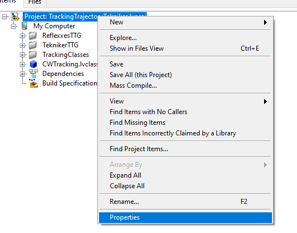
In the opened window go to Conditional Disable Symbols page and set the value for HIL symbol to “True”.
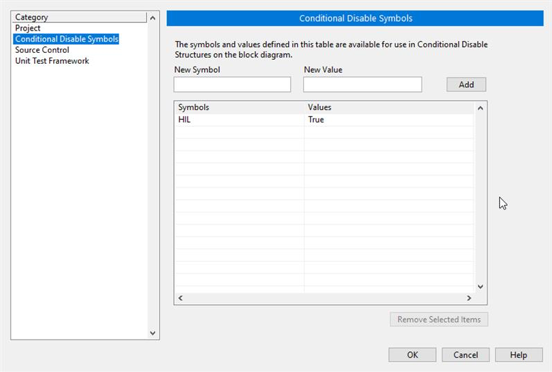
Continue with steps 3.a to 3.c of the point 6.2 in the Deployment document.
Open the RT_MCS_Main.vi (for testing the hole project)
To test just one subsystem some specific test VIs can be found inside the corresponding subsystem folder. For example the Balancing specific test VI shown bellow:
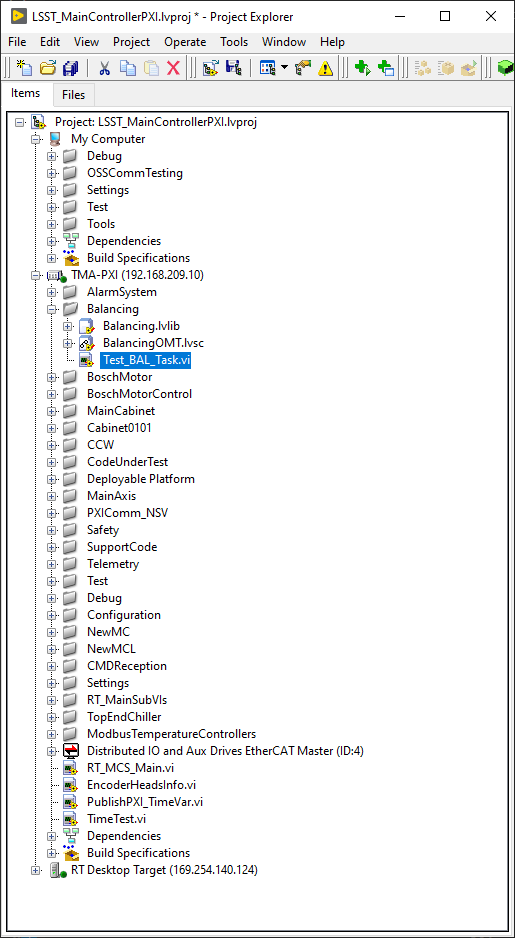
Run the VI
When the vi is deployed to the target, disconnect the target
Right click TMA_PXI target and click Disconnect
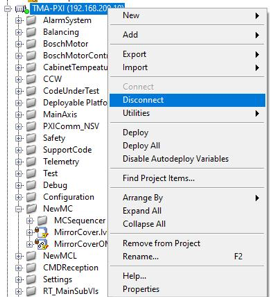
AXES PXI¶
This is the PXI where the control code for the main axes is running. To be able to configure the AXES PXI, the development PC should be configured as shown in the deployment document
Download the PXI repository: https://gitlab.tekniker.es/aut/projects/3151-LSST/LabVIEWCode/PXIController
Open the LSST_MainControllerPXI.lvproj.
Ensure that in the project properties the Conditional Disable Symbol “HIL” is set to “True”
Right click in the Axes PXI an select properties

In the opened window go to Conditional Disable Symbols page and set the value for HIL symbol to “True”.

Continue with steps 3.a to 3.c of the point 7.2 in the Deployment document.
Open the MAIN_AxesPXI.vi
Run the VI
When the vi is deployed to the target, disconnect the target
Right click AXES_PXI target and click Disconnect

Safety code deployment¶
The code that runs on the PILZ controller to simulate the behaviour of the TMA Interlock System. The source code and more documentation about configuration can be found in https://gitlab.tekniker.es/aut/projects/3151-LSST/hil/testdualmodbus
Open the “TestDualModbus” project with PAS4000 version 1.18.0
Activate the “TestDualModbus”
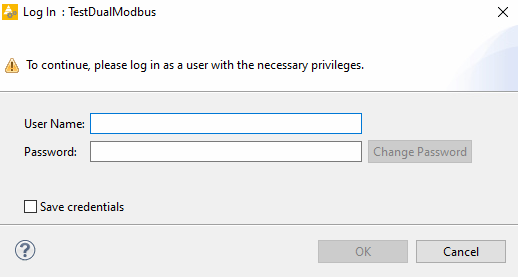
Open the online network editor

Scan project to scan the network to verify that the PILZ CPU is connected

Close the online network editor
Download the project
Open the Project downloader:

If asked to build changes say YES
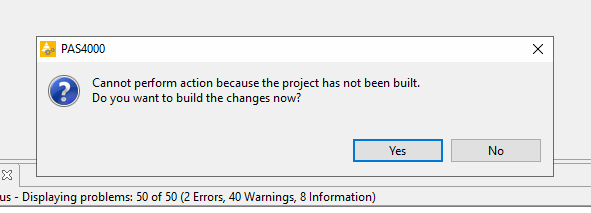
Start download:
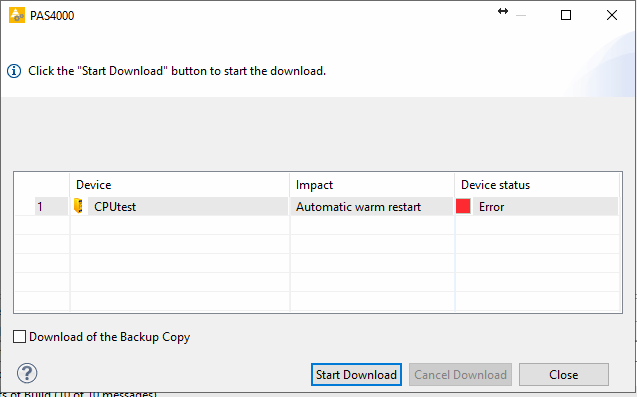
Confirm download:

Download completed:
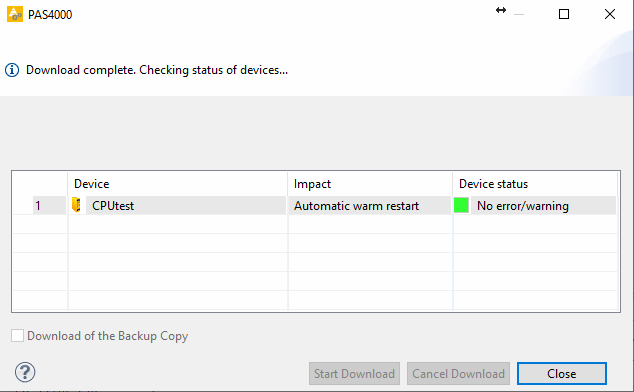
Logout:

Close the PAS4000